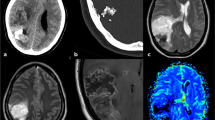Abstract
Aim
We aimed to describe the computed tomography (CT) and magnetic resonance (MR) imaging findings of intracranial extra-axial chondroma.
Material and methods
We retrospectively evaluated the imaging findings of CT and MR examinations of six patients (three men and three women, aged 21–66 years) with histopathological diagnoses of intracranial extra-axial chondroma.
Results
Four tumors were located in the frontal region and two in the cavernous sinus. All the tumors showed low signals on diffusion-weighted images and high signals on apparent diffusion coefficient maps without restricted diffusion. There was no perifocal edema in all the tumors. Cavernous sinus chondromas were associated with bone erosion and anterior displacement of the internal carotid arteries, but without calcification. Calcification was present in all frontal chondromas. All the tumors revealed low signals on T1-weighted MR images. Frontal chondromas revealed mixed signals, but cavernous sinus chondromas were brightly hyperintense on T2-weighted MR images. No enhancement was detected in the two chondromas. An intense homogeneous enhancement was detected in a cavernous sinus chondroma.
Conclusion
The imaging appearances of frontal extra-axial chondromas and cavernous sinus chondromas may have different imaging appearances. Although there is a wide range of imaging findings, the absence of restricted diffusion, perifocal edema, enhancement, and presence of low signals on T1-weighted MR images in a well-circumscribed calcified extra-axial mass should suggest an intracranial chondroma.






Similar content being viewed by others
Abbreviations
- CT:
-
Computed tomography
- MR:
-
Magnetic resonance
- T:
-
Tesla
- FFE:
-
Fast field echo
- W:
-
Weighted
- FSE:
-
Fast spin echo
- FLAIR:
-
Fluid attenuation inversion recovery
- DWI:
-
Diffusion-weighted imaging
- ADC:
-
Apparent diffusion coefficient
- GRE:
-
Gradient-recalled echo
- SWI:
-
Susceptibility-weighted imaging
- 3D:
-
Three-dimensional
- TFE:
-
Turbo-field echo
- GKS:
-
Gamma knife radiosurgery
References
Doukas A, Tallo A, Parvin R et al (2015) Giant dural supratentorial chondroma generating the question of how large can a tumor become without revealing itself. Clin Pract 5:94–98
Hirschfeld L (1851) Sur une tumor cartilagineuse de la base du crane (enchondrome). C R Sean Mem Soc Biol 3:94–96
Lacerte D, Gagné F, Copty M (1996) Intracranial chondroma. report of two cases and review of the literature. Can J Neurol Sci 23(2):132–137. https://doi.org/10.1017/s0317167100038865
Feierabend D, Maksoud S, Lawson McLean A, Koch A, Kalff R, Walter J (2018) Giant convexity chondroma with meningeal attachment. Clin Neurol Neurosurg 169:37–40
Kim E (2020) An intracerebral type of cranial chondroma. Brain Tumor Res Treat 8(1):62–65. https://doi.org/10.14791/btrt.2020.8.e8
Goldblum JR, Folpe AL, Weiss SW (2019) Enzinger and weiss’s soft tissue tumors, 7th ed. Saunders-Elsevier; Cartilaginous and Osseous Soft Tissue Tumors 30, Philadelphia, PA, pp 1052–1084
Sullivan JC, Goldsmith J, Rojas R, Varma H, Kasper EM (2019) Intracranial dural parafalcine chondroma: case report and systematic review of the literature. World Neurosurg 122:1–7. https://doi.org/10.1016/j.wneu.2018.09.169
Atalay FO, Ozgun G, Tolunay S, Bekar A (2014) Intracranial extra-axial chondroma: a case report. J Nippon Med Sch 81:35–39
Pansuriya TC, van Eijk R, d’Adamo P et al (2011) Somatic mosaic IDH1 and IDH2 mutations are associated with enchondroma and spindle cell hemangioma in ollier disease and maffucci syndrome. Nat Genet 43(12):1256–1261
Amary MF, Damato S, Halai D et al (2011) Ollier disease and maffucci syndrome are caused by somatic mosaic mutations of IDH1 and IDH2. Nat Genet 43(12):1262–1265
Fountas KN, Stamatiou S, Barbanis S, Kourtopoulos H (2008) Intracranial falx chondroma: literature review and a case report. Clin Neurol Neurosurg 110(1):8–13. https://doi.org/10.1016/j.clineuro.2007.08.020
Sebbag M, Schmidt V, Leboucq N, Bitoun J, Castan R, Frerebeau P (1990) Dura mater chondroma. a case report and review of the literature. J Radiol 71(8–9):495–498
De Coene B, Gilliard C, Grandin C, Nisolle JC, Trigaux JP, Lahdou JB (1997) Unusual location of an intracranial chondroma. AJNR Am J Neuroradiol 18(3):573–575
Guo J, Fang Q, Cheng J, Li C, Gui S, Zhang Y, Cao L (2020) Clinical and radiologic characteristics, surgical outcomes, and its possible origins of chondroma of the dural convexity. Biomed Res Int 2020:5961358
Elhakeem AAS, Essa AA, Soliman RK (2019) Chondroma of the falx cerebri: a case report and review of literature. Neuropathology 39(6):461–466. https://doi.org/10.1111/neup.12598
Duan F, Qiu S, Jiang J, Chang J, Liu Z, Lv X et al (2012) Characteristic CT and MRI findings of intracranial chondroma. Acta Radiol 53(10):1146–1154. https://doi.org/10.1258/ar.2012.120433
Demir MK, Yapıcıer O, Ertem O, Paker B, Zorlu E, Kılıc T (2023) A systematic review of cavernous sinus chondromas and an illustrative case treated with subtotal resection followed by gamma knife radiosurgery. World Neurosurg 176:66–73. https://doi.org/10.1016/j.wneu.2023.04.079
**n Y, Hao S, Zhang J, Wu Z, Jia G, Tang J, Zhang L (2011) Microsurgical treatment of intracranial chondroma. J Clin Neurosci 18(8):1064–1071. https://doi.org/10.1016/j.jocn.2010.12.028
Liu H, Cai Q, Li J, Xue Y, Zhang Y, Li Z, Zhao T et al (2022) Surgical strategies and outcomes for intracranial chondromas: a retrospective study of 17 cases and systematic review. Front Oncol 12:865865. https://doi.org/10.3389/fonc.2022.865865
Funding
Not applicable.
Author information
Authors and Affiliations
Corresponding author
Ethics declarations
Conflict of interests
The authors declare no conflict of interest.
Ethical approval
This article does not contain any studies with human participants or animals performed by any of the authors.
Informed consent
Informed consent was obtained from the patients included in the study.
Additional information
Publisher's Note
Springer Nature remains neutral with regard to jurisdictional claims in published maps and institutional affiliations.
Rights and permissions
Springer Nature or its licensor (e.g. a society or other partner) holds exclusive rights to this article under a publishing agreement with the author(s) or other rightsholder(s); author self-archiving of the accepted manuscript version of this article is solely governed by the terms of such publishing agreement and applicable law.
About this article
Cite this article
Demir, M.K., Yapıcıer, Ö., Ertem, Ö. et al. Intracranial extra-axial chondromas: clues to computed tomography and magnetic resonance imaging diagnosis. Acta Neurol Belg (2024). https://doi.org/10.1007/s13760-024-02559-0
Received:
Accepted:
Published:
DOI: https://doi.org/10.1007/s13760-024-02559-0




